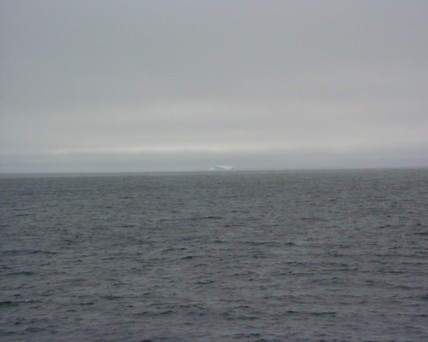|
|
Expedition
Expedition | People
|
Log - July-23-2003
by Robert McCarthy
Previous | Next
| Water, water everywhere |
|
First the answers from yesterday's questions: The amount of seawater displaced when the fuel tanks are filled is 3,975,000 liters, which is about 4,066,500 kg (4500 tons).
|
 |
Last night I saw my first iceberg, and although we didnít get too close, it was impressive for a ďlittle-oneĒ. It was hard to judge the size of it, but letís say that it was 20 meters high, 100 meters long, and 100 meters wide. Letís calculate how many gallons of fresh water is contained in that iceberg. First we need the volume of the iceberg exposed, 200,000 meters cubed. Knowing the density of ice is 920 kg per meters cubed, and the density of seawater is 1023 kg per meter cubed, we can determine how much ice is below the water line. Archimedes Principle states that the weight force down is equal to the weight of the displaced fluid. So the ratio of the two densities will give the fraction of the volume of the total iceberg that is submerged (displacing the water). Here, it turns out that 90% of the iceberg is submerged, or 10% is visible. This means that the volume of the total iceberg is 2 million meters cubed, which is 2 billion liters of fresh water. This equates to 530 million gallons of water!! |
|
Speaking of fresh water, the ship has to create its own fresh water while at sea. There are a few ways to do this, reverse osmosis and evaporators are the two most common. The USCG Healy uses evaporators, and can generate about 6600 gallons per day, (thatís about 55 gallons per person per day with a crew of 120 on board). They pump seawater into the ship, and decrease the pressure so it will boil at a lesser temperature. The steam then passes over some condensers, and fresh water drips into collection pans. This water then goes through a bromine filter, and is extremely pure. The Healy can hold about 28,000 gallons of water combined in two tanks, and conservation measures are taken if the level reaches half that amount. |
|
On a side note, we've been heading about 346 degrees for the last day (slightly west), and we gained back the half hour time zone of Newfoundland. So now we are only 1 hour ahead of Eastern Standard Time. We are just now crossing over latitude 60 degrees north. Still a long way to go before our first station in the middle of Baffin Bay.
|
|
